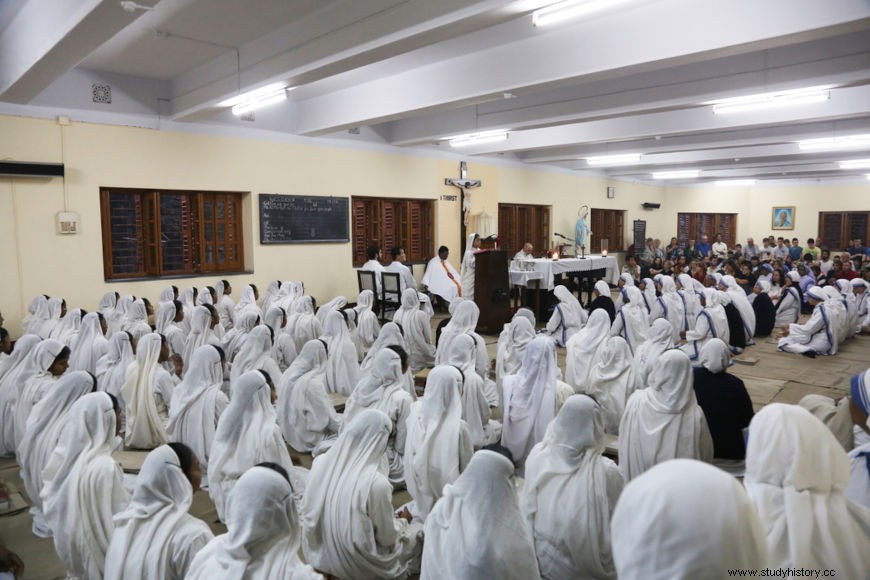
Mother Teresa of Calcutta she was an Indian nun who became internationally known for her humanitarian work in India. She was the founder of the Missionaries of Charity order, which cared for the poor, orphans and the sick free of charge. She received the Nobel Peace Prize in 1979 for her work.
Also :Alfred Nobel, the creator of the Nobel Prize
Mother Teresa of Calcutta Summary
-
Mother Teresa of Calcutta was born in Skopje, capital of present-day North Macedonia.
-
she joined the order of the Sisters of Loreto in 1928, moving to Ireland in the same year.
-
she served as a nun in the Sisters of Loreto until 1948, when she left the order to carry out humanitarian work in Calcutta on her own.
-
she Founded the order of Missionaries of Charity, making it famous and spreading branches of it across India and other countries on the planet.
-
She was awarded the Nobel Peace Prize in 1979.
-
she passed away in 1997, a victim of heart failure.
Anjezë Gonxhe Bojaxhiu was born on August 26, 1910. The city in which she was born was known at the time as Üsküp and was part of the Ottoman Empire. Today, the place is known as Skopje, being the capital of North Macedonia, a country that emerged in the early 1990s during the break-up of Yugoslavia.
Recognized internationally as Mother Teresa of Calcutta, she came from an extremely Catholic Albanian family . Her father was called Nikola Bojaxhiu and worked as a businessman, while her mother, Danafile Bojaxhiu , she was a housewife, taking care of the home and her children.
When Anjezë Bojaxhiu was eight years old, her father died and her mother was forced to work selling fabrics and embroidery. Even in childhood, she had the first signs that she wanted to pursue a religious career. At the age of 12, she was already talking openly that she wanted to become a nun , and at the age of 17, she decided she really would be one.
Ecclesiastical Career of Mother Teresa of Calcutta
Anjezë Bojaxhiu adopted the name “Mother Teresa” throughout her religious career, her first step in this direction being to join a convent located in Ireland. At the age of 18, she entered the Institute of the Blessed Virgin Mary , also known as Sisters from Loreto . This religious order had missions in India, a fact that was essential to attract the young woman's interest.
She moved to Ireland in 1928 and she never saw her sister and mother again. Mother Teresa's period in that country served as a preparatory for religious missions that she would fulfill in India. It was in the Sisters of Loreto that she came to be called Teresa, a gesture inspired by the name of Teresa from Lisieux, also known as Saint Therese of the Child Jesus and the Holy Face .
She was sent to India in early 1929 , still in the period of novitiate, that is, during her period of formation as a nun. She took her religious vows, officially becoming a nun on May 24, 1931. From that moment on, she was known as Teresa.
Thus, she settled in a convent of the Sisters of Loreto in Calcutta and went on to work as a history and geography teacher in a school maintained in that order. From 1937, Teresa became the director of one of the schools maintained by the Sisters of Loreto and became known as Mother Teresa.
Login also :Mahatma Gandhi, known as a defender of peace
Mother Teresa of Calcutta's Charities

As a nun of the Sisters of Loreto, Mother Teresa could not live outside the convent. However, from the 1940s onwards, she felt the need to extend her charitable work beyond the convent walls. In order for her to be able to carry out this work, she needed to abandon the Sisters of Loreto.
She wanted to do humanitarian work to help the poorest section of the population of Kolkata by providing them with shelter, food, medical treatment etc. Her desire was fueled by the scenario India was facing at that time of famine, which led to millions of people's deaths, and the growing violence between Hindus and Muslims in that society.
Thus, Mother Teresa of u start of the process to leave the Sisters of Loreto , which lasted two years. Mother Teresa left the convent in August 1948, after 20 years in that religious order. So she moved to a peripheral region of Calcutta and started his charity work.
Mother Teresa adopted Indian citizenship, underwent medical training, and then founded a small school in Calcutta. In early 1949, she had some volunteers who took care of the poor. The growth of the charitable work she coordinated allowed her to receive authorization from the Vatican to establish a religious order, and thus the Missionaries was born. da Charity, in October 1950.
In 1952, the Missionaries of Charity established a house from rest that received people in precarious health conditions. The purpose of this place was to give some medical treatment and to grant rest and some comfort to the dying. This house was named after Nirmal Hriday, translated as “Place of the Immaculate Heart”.
In addition, a house was opened to receive people suffering from leprosy, and this place was named Shanti Nagar, translated as “Place of Peace”. The Missionaries of Charity also ran an orphanage , providing shelter, education and medical care to orphaned children until they were adopted by other families.
Over time, the humanitarian work of the Order of Mother Teresa was recognized, and new places began to receive humanitarian actions developed by the Missionaries of Charity. In the 1960s, the order began to develop its work internationally by opening houses in countries such as Venezuela, Italy, Tanzania and Austria.
Mother Teresa was also known for her work in caring for people who suffered from AIDS, in the 1980s, and also worked rescuing children who suffered from the war in Lebanon, in 1982. Her work was recognized internationally and won her the Nobel Peace Prize in 1979, in addition to other international awards.
Death of Mother Teresa of Calcutta
From the 1980s onwards, Mother Teresa's health began to show the first signs of decline. In 1983, she suffered her first heart attack, and in 1989, she suffered a second attack, causing her to receive a pacemaker. In the early 1990s, her health problems continued, and she developed illnesses such as pneumonia and malaria.
Despite the pacemaker, Mother Teresa's heart remained fragile, and on September 5, 1997, she died of heart failure . Her death caused international commotion, and her funeral was attended by thousands of people across the planet. Her body was buried in Calcutta, where she resided for most of her life.
After her death, Mother Teresa was beatified by the Catholic Church on account of an alleged miracle she performed in curing a woman's cancer. The Vatican opened the process of beatification, and she was beatified in 2003 and sanctified in 2016.
Login also :Martin Luther King Jr. and the fight against racism
Criticisms of Mother Teresa of Calcutta
Despite being internationally recognized for her humanitarian work in providing medical care, shelter, food and education to the poor and sick, Mother Teresa suffers from criticism from people who question some of her actions. .
In this sense, some point out that the sick in the homes of the Missionaries of Charity did not receive adequate medical treatment . These people accuse that many patients suffered from constant pain, as they did not receive effective painkillers. In addition, the hygienic conditions of these houses are also criticized.
There are also those who criticize the way the religious order managed the money from donations, as many denounced that part of the money was not used and that part of it had questionable origins. Finally, there are those who question Mother Teresa's relationships , who was close to people like Haitian dictator Baby Doc .
Quotes from Mother Teresa of Calcutta
Mother Teresa's life and work are an inspiration to many people. In addition to a life of good works, the nun is known for some striking phrases|1| , such as:
-
“Often, a single word, a look, a quick gesture, and darkness fills the heart of the person we love.”
-
“There are many people in the world dying for lack of a piece of bread, but there are many more people dying for lack of a little love.”
-
“If you judge people, you don't have time to love them.”
-
“We can cure physical ailments with medicine, but the only cure for loneliness, despair and hopelessness is love.”
-
“Yesterday is gone. Tomorrow hasn't arrived yet. We only have today, let's begin!”
Note
|1| 16 extraordinary phrases from Saint Mother Teresa of Calcutta. To access, click here.
Image credits
[1] mark reinstein and Shutterstock
[2] Zvonimir Atletic and Shutterstock
